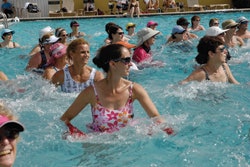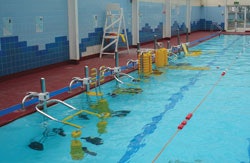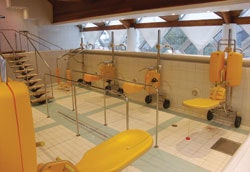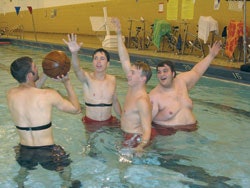Aquatics professionals are targeting all age groups with a wide variety of upright exercise programming.
 Photo of an outdoor water aerobics class
Photo of an outdoor water aerobics classMarci Callan has spent a good chunk of her life in or near pools, but she'll be the first to admit that swimming is boring. "I hate to say it," acknowledges the aquatics specialist for the Fairport (N.Y.) Central School District and head coach/general manager of the Fairport Area Swim Team. "Kids today are instant-gratification kids. They get bored, they check out. But if you change an activity every 15 or 20 minutes, they are more engaged."
That may explain why FAST is the only club in USA Swimming's Niagara District to qualify and send swimmers to the annual Junior and Senior National Championships on a consistent basis. For the past five years, Callan has incorporated vertical aquatic exercise into the team's workouts at Fairport High School's pool and diving well, putting swimmers through a rigorous training circuit that includes weights, deep-water running, underwater cycling and core-strength activities. Rather than simply swimming laps, team members spend sizeable amounts of time at each station for one or two practices a week, taking advantage of the greater resistance water provides while reducing the risk of muscle or joint injury.
Members of Fairport High's cross country and track teams, as well as injured student-athletes in other sports, have taken to underwater training, too. "We find there are a lot of similarities between runners and swimmers, and we can actually train some of them at the same time," Callan says. "We also have discovered in the past few years that we can vertically train swimmers who have been injured, and they've finished their seasons - with very little traditional training - by posting best times and performing at the state level."
Vertical aquatic exercise has been so successful that Fairport High now offers an abbreviated 20-minute workout for physical-education classes. "We've approached this almost as a form of holistic training that keeps kids mentally fresh," Callan says. "All this training goes along with their academics. It's relaxing, and it helps them think clearer, because their blood circulation is better. During land exercise, the blood pools in your feet; when you're in the water, it doesn't. So all your systems are operating on a higher level when you train this way."
The efforts of Callan and her staff coincide with a national effort to attract a younger demographic to those aquatic activities that have traditionally drawn older participants. "We are seeing a trend toward higher intensity training programs that entice the younger market into the pool," says Angie Proctor, executive director of the Nokomis, Fla.-based Aquatic Exercise Association, citing increases in the number and types of deep-water cardio and strength training classes that facilities offer, as well as aquatic adaptations of such popular dry-land activities as kickboxing, yoga, Tai Chi and even Pilates.
 UPRIGHT POSITION Water fitness expert Mark Grevelding says an on-deck instructor provides a stronger focal point for both new and experienced participants.
UPRIGHT POSITION Water fitness expert Mark Grevelding says an on-deck instructor provides a stronger focal point for both new and experienced participants.Between 2004 and 2009, the average age of aquatic exercise participants dropped from 57 to 45, according to AEA data. Says Proctor, "I'd really like to see that hit 30."
Aquatic exercise didn't always attract only "little old ladies in shower caps" looking for a social hour, says John Spannuth, president and chief executive officer of the Boynton Beach, Fla.-based U.S. Water Fitness Association. After World War II, young veterans took to the water in an effort to speed the healing of battlefield wounds. That, Spannuth claims, encouraged the consideration of water as both a therapeutic and preventive measure.
"It was seen as a gentle form of exercise, and it stayed that way for quite some time," says Mark Grevelding, a training specialist and programs and promotions coordinator for AEA, as well as an independent water fitness instructor. Then, to coincide with the aging of baby boomers - "the most athletic generation," according to Grevelding - more aquatic facilities began to provide individuals suffering from hip and knee issues with a variety of workout programs in non-weight-bearing environments. "It was incumbent upon the industry to develop aggressive programming to appease this huge crowd that was heading to the pool," says Grevelding, who teaches aquatic kickboxing to people over 60 at a YWCA in Syracuse, N.Y. "Now, we still have to battle a huge myth that aquatic fitness is strictly for older adults - or older women, to be even more specific - because that's just not the case anymore."
In the early 2000s, a movement began to bring popular land-based exercises into the pool. Classes with names based on variations of the terms "aqua," "exercise," "water" and "fitness" eventually morphed into "Pool Muscle Mixers," "Aqua Cardio Blast" and "Liquid Flex & Flow." "You can teach cycling in the water, you can teach kickboxing in the water, you can do full strength classes in the water," Grevelding says. "When you do that, you're really piquing the interest of different groups of people. You have to make your schedules sound interesting, because if they don't, people are not going to go. If you want to change your image, you've got to get creative."
"Fewer than five percent of Americans can swim 400 yards without stopping, but 98 percent can walk in the water," Spannuth adds, stressing that the shift to more aggressive programming can be gradual. "Water walking is like a magic magnet that attracts people to pools. It's a way of getting them there."
Indeed, water walking often is the easiest way to introduce aquatic exercise to a variety of age groups, including pre-teens. Because classes typically are held in shallow and chest-deep water, participants need not be proficient swimmers, and the fact that their heads are above the surface at all times can result in a more relaxed and social environment. But walking back and forth across a pool can quickly become monotonous. That's why an energetic and imaginative instructor is key. Classes should include a variety of walking routines - forward, backward, sideways and diagonal - sometimes accompanied by arm motions or other movements.
Water walking can be a bridge to other types of aquatic fitness activities. Facility operators may want to consider hosting dry-land seminars, during which aquatics instructors educate participants about the benefits of pool exercise - including the fact that water is 12 times more resistant than air and that aquatic exercise participants work their muscles in pairs, because they are entirely submerged. Thus, during elbow flexion and extension exercises (curls), participants are muscle loading their biceps and triceps. A dry-land elbow flexion exercise would work only the biceps.
 CIRCUIT SYSTEM Large pieces of portable in-pool fitness equipment allow for more programming options, but they can be pricey.
CIRCUIT SYSTEM Large pieces of portable in-pool fitness equipment allow for more programming options, but they can be pricey."Then take them into the water and unload shock and awe with your most amazing exercises," Grevelding says, adding that it's important to emphasize the cross-training benefits of water fitness to athletes. "If someone is a runner, running in water vertically with a buoyancy belt on is one of the best ways to cross-train, because they're unloading their joints and working very hard on movement patterns."
Regardless of the type of water activity they're overseeing, instructors should be positioned on deck, Grevelding says. There, they provide a focal point and encourage engagement among group members. On-deck instructors also are better able to observe and correct participants' incorrect body alignment. And, just as in land-based group exercise classes, the music that accompanies water workouts should be appropriate to the type of activity and participant demographics.
Once a facility establishes a comprehensive aquatic exercise program that encompasses numerous age groups and skill levels, it can keep things going through continuous promotion that encourages newcomers. "We're trying to really step this up and show that you can make it fun and challenging," Grevelding says.
Callan's fun and challenging approach with FAST and Fairport High students reflect a vision in which, at an early age, water exercise becomes as natural as land-based exercise. "I can guarantee you nobody else is doing this in P.E. classes. When you're dealing with high school females, and you can say you have an aquatic activity that's not going to get their hair wet, that's a huge bonus," Callan says. "We're looking for kids who want to try something different and not do the same old thing everyday. We know there's a different way."
Credit Fairport's different way, at least in part, to USA Swimming's commitment to helping aquatic facilities achieve self-sustainability by offering any combination of learn-to-swim programs, aquatic therapy programs, water fitness programs and swim teams. "USA Swimming, in the past five years, has really embraced the idea that not every child is going to be on a swim team," says Sue Nelson, aquatic program specialist for the sport's national governing body. "But if we are going to help children become fit and feel safer in the water, we should offer fitness programs that incorporate both vertical and horizontal planes."
Nelson is convinced that introducing aquatic exercise to young people - especially kids that show early signs of obesity - can eventually help them transition to swimming and general exercise. "Kids can start in the water, gain confidence and get comfortable," she says. "And then the aquatics professionals can start talking with them not only about exercise but also about health, wellness and nutrition and how that applies to their land activities and gives them more energy. That creates a passion and gives them more opportunities to carry on with swimming. It's very easy to blend everything once your staff understands the components."
 Photo of portable in-pool fitness equipment
Photo of portable in-pool fitness equipmentNelson suggests creating programs that incorporate a class instructor, a nutritionist and a cardiologist. Callan, meanwhile, complements her vertical aquatics regimens with educational information, explaining to kids that their heart rhythm is 13 to 17 beats slower per minute in water, and using anatomical charts for injured student-athletes to pinpoint where they're experiencing pain, which helps them better understand how the body (and water rehab) works.
Amanda Sharpe, a pediatrician and supervisor of the health, wellness and fitness division at the YWCA Elmira & the Twin Tiers in New York State, recently introduced a discounted program for obese children and their families. Fit & Fun: Uniting Families with Fitness encourages hitting the facility's pool for open swim at least twice a week. "When you get into middle school and high school - with the exception of football and wrestling for boys, and softball and maybe shot put for girls - there are few opportunities for heavier children to participate in sports," says Sharpe, who stresses Fit & Fun is not a weight-loss program, although a nutritional component and family cooking classes are in the works. "I want to make it fun. I don't want the kid to feel like his parents are dragging him here and making him get in the pool for an hour."
Callan tells the story of a 400-pound Fairport High senior, whose doctor prescribed aquatic exercise. The boy was so large that he had to pass through a doorway sideways, she remembers. "But he was an athlete underneath, and we trained him like an athlete," says Callan who strapped a heart-rate monitor on him, developed a water-running routine for him and also incorporated medicine balls and underwater cycling into his workouts. "Within the first four weeks, he lost 40 pounds."
Initially, the boy trained during his regular P.E. class every other day, and then he began combining his P.E. class with a private session during his lunch break. Soon, he was working out in the pool daily both during and after school. Callan discussed food intake with him and trained him as she would a lifeguard. Because basketball was the boy's favorite sport (even though his size prohibited him from playing competitively), she asked the school's varsity boys' basketball coach to send a few players over to the pool to work out with him and play water hoops. By the time he graduated, the boy was off medication directly related to his weight, and he was working as a lifeguard at the local YMCA.
The main reason for Callan's discretion early on was to prevent the student from feeling self-conscious in a swimsuit around his peers. "It is important to acknowledge that that's a problem," Grevelding says. "But most of those people are in the same boat, and after a couple times, they get much more comfortable with it."
"An aquatics facility has to be very flexible in allowing apparel," Nelson adds. "If cutoffs are clean with no unraveling - and a person is comfortable in them - allow the shorts in the water."
 SHOOTING POOL At Fairport (N.Y.) High School, students and athletes participate in aquatics-based physical-education courses and other activities.
SHOOTING POOL At Fairport (N.Y.) High School, students and athletes participate in aquatics-based physical-education courses and other activities.Aquatic exercise programs require minimal investments in equipment. Neoprene-covered hand weights from the weight room along with tubing, bands and balls from the fitness room work just fine, according to the AEA's Proctor. "We've seen a lot of strength equipment coming into the water," she says. "But it's more the type of equipment that an individual will hold. The larger, higher-end equipment is just very hard for an aquatics budget to handle."
Proctor is referring to in-water exercise equipment, including a new line of portable circuit training pieces that can transform any pool with a depth of at least 3.6 feet into a zero-impact water gym. Recently introduced to the North American market via distribution from Kelowna, B.C.-based Waterplay Solutions Corp., the equipment was invented in Scotland and looks similar to land-based circuit-training pieces. Each unit is anchored to the deck via receiving collars that must be retrofitted in existing facilities, and all eight pieces can be installed or removed in about 15 minutes, according to Cory Forrest, Waterplay's product line manager. The full eight-piece set sells for approximately $60,000, but individual pieces are available. Waterplay also recommends that a separate room be used to store the pieces.
Additionally, Hollywood, Fla.-based Aqquatix USA recently started distributing underwater exercise pieces made in Italy to the U.S. market. Its line of portable products includes bikes, treadmills and multipurpose equipment ideal for aquatic Pilates.
On the other hand, aquatic kickboxing does not require any equipment, although webbed gloves that provide resistance to more advanced participants can be purchased at reasonable prices. Additionally, Speedo offers online discounts of at least 50 percent on its line of Hydro Resistance swim gloves and hand and leg weights, and Aqua Sphere (which recently became an official sponsor of the AEA) manufactures numerous water weights, shoes and other training gear.
Callan uses a combination of small and large equipment, and Fairport High currently owns several dozen buoyancy belts, 10 underwater cycles and one underwater treadmill. The athletic department helps pay for it all, and various partnerships allow for deals on demo equipment or trade-show models.
Forrest admits that promoting a product with the kind of price tag the Waterplay line carries can be challenging in a turbulent economy. In fact, the company is still looking for its first North American installation. But most of the questions he receives from potential buyers focus more on the literal nuts and bolts of the equipment and its installation than cost. "Every facility is looking for ways to generate more revenue, and adding this equipment allows you to offer more programming in your pool," Forrest says. "But it's still a challenge."
The same can be said for aquatic exercise programmers everywhere. "It's an uphill battle," acknowledges the AEA's Proctor, whose organization continues to redefine aquatic exercise for new generations of participants. "But we are making a lot of progress."
Callan, who hopes to trademark her brand of "aquatic cross-training," is doing her best. Fairport High's athletic director has worked out under her staff's tutelage and is completely supportive of her efforts, and the school's athletic trainer reports a decrease in the number of injuries suffered by athletes (not just swimmers) who work out in the pool. "We had all the right elements in place, and we all bought into it, which is incredible," Callan says. "And we are getting interest from other schools and aquatics directors about what we're doing. This can be implemented in other places, but people have to believe in it. You have to be passionate about it and know where you're going. The key is realizing that the swimming pool is not just for swimmers."




































